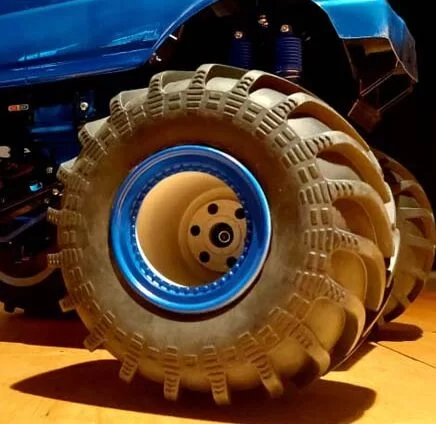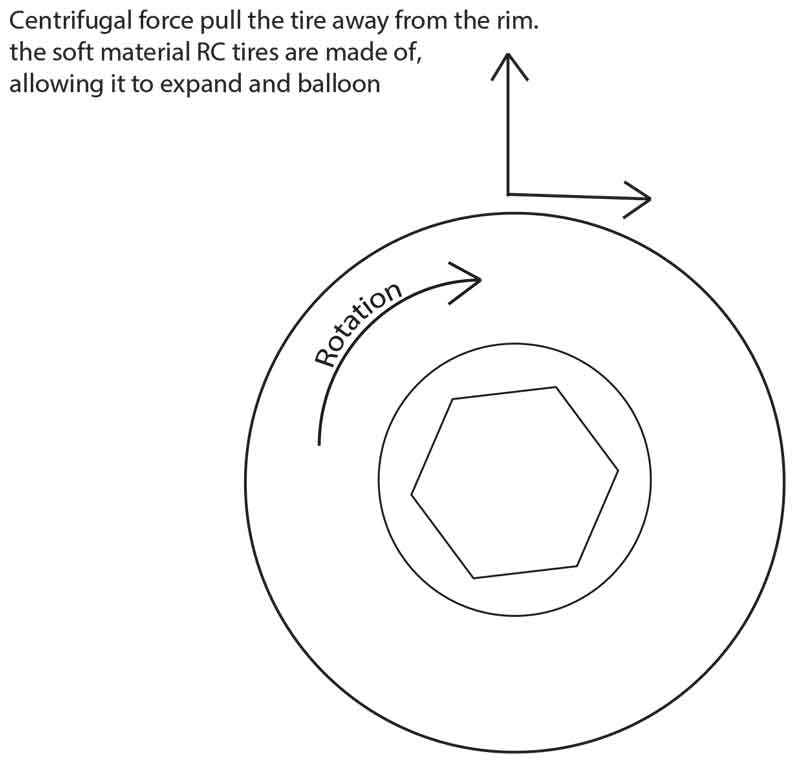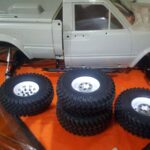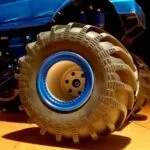Why Do RC Cars’ tires balloon (+How to prevent)


A lot of hobbyists consider ballooning their tires to be some sort of necessary evil to boost the speed of their RC cars. This occurs most especially in professional racing. Some drivers still insist that ballooning RC tires does more good than harm to your vehicle.
Really and truly, information is power so here are a few basic things you need to know about ballooning in tires before you decide whether or not to agree with such statements.
Ballooning in RC tires occurs when the car’s tires attain a certain centrifugal force while being driven at very high speeds. At high speeds, the centrifugal force causes the tires to expand, and due to the soft texture of the rubber they are made of they balloon.


How does the centrifugal force affect the RC tires?
The centrifugal force pulls the tire away from the center (wheel) and causes the tire to expand and balloon.
The more centrifugal force is generated, the more the tire will experience deformation and lose its firmness.
As the RPM of the tires increase, so also will the centrifugal force. The expansion starts off slightly and gradually increases until the tire is unable to expand further and rips open.
Is it normal for RC tires to balloon?
Yes, it is normal for RC tires to balloon.
Ballooning in RC tires happens to most RC tires when they are made to rotate at a very high speed. It is not something you plan on experiencing because it does not have a specific speed level that kick-starts it.
Do all types of RC tires balloon?
Yes, all types of RC tires balloon.
This is because they are all made out of the same type of material – synthetic rubber.
Naturally, synthetic rubber is very soft. when it has been made into RC tires, it fails to retain air pressure and this is what forms the basis of ballooning.
Like any other elastic material, rubber has a certain yield point at which it has attained its greatest state of elasticity i.e it has exceeded its breaking point. It is on arriving at this so-called yield point that the expansion begins. Therefore, no matter the company that makes the RC tire, except if extra steps are being taken during production ( belting of tires), the car tire will balloon when the RPM generates an excessive amount of Force.
How does ballooning affect your RC car?
Ballooning in tires increased the top speed of your RC car while driving. Making it go faster, BUT your ability to retain control of the car and maneuver the car properly will significantly reduce.
At a more severe point of ballooning, turning and steering the vehicle becomes extremely difficult and movement becomes unpredictable due to the reduce of the contact patch. The end result in such cases is uncontrollable driving, that usually ends with the car flipping and crashing, but in some cases, the situation doesn’t get that out of control.
Jerky and uncontrollable movement is also one of the characteristics of an RC car that is about to reach the point of no return due to ballooning in the tires.
Being a professional driver isn’t a guarantee that you will be able to maintain full control of your vehicle when it’s tires ballooning. Having great expertise in driving an RC car increases your percentage of crashing greatly, because it would be more likely for the expert to be driving at exceptionally high speeds. In a nutshell, when it comes to ballooning in tires, it is wiser to pick the option of prevention rather than winging it.
Does ballooning ruin your RC tire?
Ballooning ruins your tire.
It causes your tire to slack and lose its firmness. There is also a deformity in its shape due to the expansion (the diameter increases and the circumference becomes wider) experienced during the ballooning process. The tire reaches its breaking point and is unable to contract back to its original shape and size, therefore, condemning the tire.
How do I stop my RC tires from ballooning?
Prevention is better than cure! The following methods can double as the prevention and cure for ballooning in RC tires.
To make sure that we stay economical while still being effective, all the materials that would be mentioned here can easily be found within your home.
How to tape RC tires
Taping the RC tire is one of the most commonly used ways to prevent ballooning. It is the less dificult and most effective prevention of RC tire ballooning.
Here is a guideline on how to tape your RC tire:
1. Firstly, Inspect the body of each of the tires to make sure that they aren’t punctured already. Check if the rims are glued to the tires or not. If they aren’t, gently separate the rim from the tire.
2. When the rims have been removed, turn the tires inside out. This is because the tape will be applied to the interior of the tire, and turning it inside out helps you to align the tape properly.
3. Spray a cleaning Solution spray on the tire and let it dry off. We do this to prevent dirt particles from sticking to the tape later on. This isn’t a necessary step when dealing with new tires.
4. Apply your duct tape. Ensure that it is as centrally placed as possible. If it is not centrally placed, the tire will lack firmness and air will get into the tire anyway.
5. Turn the tires back to the right side then press your fingers firmly along the sides of the tire.
6. Put your foam inserts in, and align them perfectly with the tires.
7. Place your wheels back into the tires. Then test run the tires to ensure that the experiment was a success.
Does gluing prevent ballooning?
NO! Gluing does not prevent ballooning.
Rather, gluing your RC car’s tires makes it easier to condemn the tires after a situation of ballooning. When the wheel is glued to the tire, you will be unable to take them apart to change the foam insert or re-align the tape inside. But gluing can be helpful when taping the insides of the tire. This helps to ensure that the tape sits in one place and does not move later on.
Does foam in the tires prevent ballooning?
Yes, placing foam inserts into the car tires prevents ballooning.
Inserting foam into tires is a good way to prevent ballooning. It encourages firmness in the tire and helps the tire to retain its shape, since air pressure is not applicable within it. Foam inserts help to properly distribute the centrifugal force evenly to all areas of the tire.
Do belted RC tires balloon?
Belted tires rarely ever balloon.
The thing with belted tires is that they do not give much problems while driving with them within a certain range of speed limits. Belted RC tires are highly beneficial and applicable to almost all road surfaces. Now, the issue in the use of belted RC car tires, is the fact that they are very limited in how fast they can go.
At the point where such a limit is exceeded, the belt can break off. When this occurs, ballooning in the tire becomes a likely situation, but not guaranteed.
Bonus Info: Do conventional car tires also balloon?
Ballooning does not occur in conventional cars because the tires found in such vehicles are made much thicker and firmer than the ones found in RC cars. The firmness does not allow the tire to expand and change its form, cause ballooning.
Conclusion
Ballooning in RC cars is not as fun as the name implies. Without proper understanding of the term, one can easily assume that driving an RC car to such a speed that the tire itself becomes ballooned, is not a bad thing.
Ballooning is one of the causes of RC car crashes and there really is no point to spending so much time and energy to build an RC car only to have it destroyed in the most unimaginable way possible. So try as much as possible to maneuver your RC car within speeding limits and take whatever step is necessary to stop the tire from ballooning.
Extra Read
How RC tires are made (the full process)
Best RC tires for any surface (belted&non belted)





